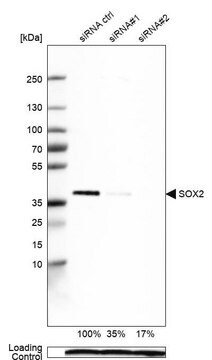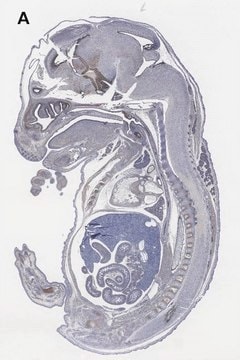AB1528
Anti-Nerve Growth Factor-β Antibody
serum, Chemicon®
Synonym(e):
NGFbeta
About This Item
Empfohlene Produkte
Biologische Quelle
sheep
Qualitätsniveau
Antikörperform
serum
Antikörper-Produkttyp
primary antibodies
Klon
polyclonal
Speziesreaktivität
rat, human, chicken, mouse
Darf nicht reagieren mit
bovine
Hersteller/Markenname
Chemicon®
Methode(n)
ELISA: suitable
immunohistochemistry: suitable
western blot: suitable
NCBI-Hinterlegungsnummer
UniProt-Hinterlegungsnummer
Versandbedingung
dry ice
Posttranslationale Modifikation Target
unmodified
Angaben zum Gen
human ... NGF(4803)
Spezifität
Immunogen
Anwendung
Neurowissenschaft
Neurochemie & Neurotrophine
Immunoblotting at 1:500-1:5,000.
ELISA at 1:500-1:5,000.
Inhibition of biological activity in vitro at 1:10-1:50.
BIOLOGICAL ACTIVITY: Neutralizes NGF, but not other neurotrophins.
Use neat for in vivo animal studies (5-10 μL/g body weight).
Optimal working dilutions must be determined by end user.
Physikalische Form
Lagerung und Haltbarkeit
Rechtliche Hinweise
Haftungsausschluss
Sie haben nicht das passende Produkt gefunden?
Probieren Sie unser Produkt-Auswahlhilfe. aus.
Lagerklassenschlüssel
10 - Combustible liquids
WGK
WGK 1
Flammpunkt (°F)
Not applicable
Flammpunkt (°C)
Not applicable
Analysenzertifikate (COA)
Suchen Sie nach Analysenzertifikate (COA), indem Sie die Lot-/Chargennummer des Produkts eingeben. Lot- und Chargennummern sind auf dem Produktetikett hinter den Wörtern ‘Lot’ oder ‘Batch’ (Lot oder Charge) zu finden.
Besitzen Sie dieses Produkt bereits?
In der Dokumentenbibliothek finden Sie die Dokumentation zu den Produkten, die Sie kürzlich erworben haben.
Unser Team von Wissenschaftlern verfügt über Erfahrung in allen Forschungsbereichen einschließlich Life Science, Materialwissenschaften, chemischer Synthese, Chromatographie, Analytik und vielen mehr..
Setzen Sie sich mit dem technischen Dienst in Verbindung.






